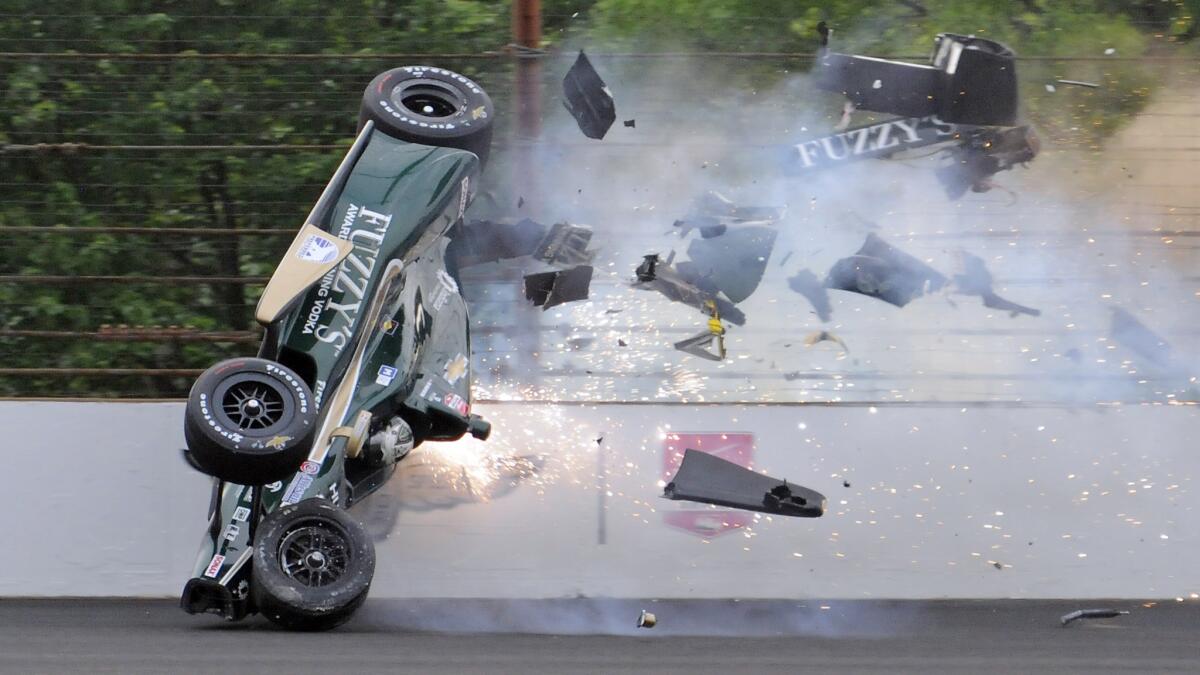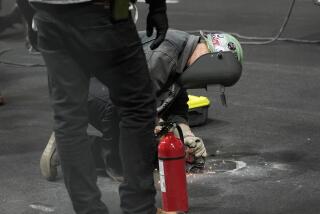IndyCar Series makes changes to cars after Ed Carpenter practice crash

Ed Carpenter hits the wall at Turn 2 of the Indianapolis Motor Speedway during a practice session Sunday in preparation for next weekend’s
- Share via
IndyCar Series officials have implemented changes aimed at slowing down cars and increasing safety after another car flipped during an Indianapolis 500 practice session on Sunday morning.
Ed Carpenter became the third driver in less than a week to flip his car after crashing into the Turn 2 wall at the Indianapolis Motor Speedway. Carpenter was uninjured and walked away from the crash, slamming down his helmet in frustration before entering an ambulance for precautionary checks.
After meeting with team representatives, IndyCar Series officials announced the cars would return to their lower, prequalifying turbocharger boost levels. The lower boost levels will reduce power by around 50 horsepower, meaning speeds likely will be held to under 230 mph. In an additional move to scrub speed from the cars, teams will have to run the same aerodynamic configurations for qualifying and the race.
“This problem is solvable,” said Derrick Walker, president of operations and competition for the IndyCar Series. “We need to err on the side of safety and I’m confident we will be able to resolve this issue.”
Qualifying, which was delayed after the Carpenter crash, is scheduled to start at 12:15 p.m. PDT.
Carpenter’s crash renewed questions as to whether the new aerodynamic design of the cars makes them susceptible to flipping. Three-time Indianapolis 500 winner Helio Castroneves was involved in a spectacular crash Wednesday when his car flipped high into the air after making contact with the wall. The next day, Josef Newgarden, Carpenter’s teammate, flipped over after his car crashed into the wall.
In each of the three crashes, the cars flipped as they spun around. There have been concerns over whether the cars, when turned to the side or backward, are prone to flipping when traveling at high speeds.
The aerodynamic body kits designed by Chevrolet and Honda are being used at the Indianapolis track for the first time ahead of next Sunday’s Indy 500. Each of the crashes involved Chevrolet cars. IndyCar Series officials said last week that there were no obvious design flaws that would explain why the cars would flip after being spun.
Chevrolet teams were told Thursday to remove a small aerodynamic wicker that ran the length of the car’s nose. After conducting additional aerodynamic studies, Chevrolet determined that the wicker may have played a small role in causing Castroneves to flip.
Carpenter was among those who criticized the decision to remove the wickers but expressed concern over the crashes involving Castroneves and Newgarden.
“We haven’t had cars doing that ever in my career, but things are a lot different this year,” Carpenter told USA Today on Thursday. “There’s aero kits. There’s a giant hole in our underwing. There’s a lot of things that are different. I don’t know that we understand why it’s going on at this point.
Carpenter said he wasn’t sure what prompted him to lose control during his crash Sunday.
“It caught me by surprise,” Carpenter said. “I wasn’t expecting to swap ends. The car was actually feeling pretty good, better than it did yesterday. Things are a little unpredictable right now.”
Qualifying for the Indianapolis 500 is scheduled to continue Sunday after Saturday’s session was postponed because of rain.
More to Read
Go beyond the scoreboard
Get the latest on L.A.'s teams in the daily Sports Report newsletter.
You may occasionally receive promotional content from the Los Angeles Times.











